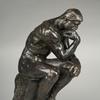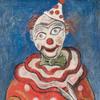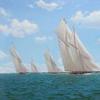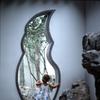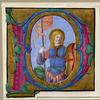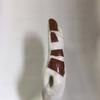The Genius of Martin Johnson Heade
- ATHENS, Georgia
- /
- May 05, 2017
Dramatic landscapes, exotic subjects and vibrant colors all characterize the work of the once forgotten artist Martin Johnson Heade. Now recognized as one of the most important American painters of the 19th century, Heade devoted equal time to landscape, marine and still-life subjects, but is best known for his studies of tropical birds and flowers.
The Georgia Museum of Art at the University of Georgia will present the exhibition “The Genius of Martin Johnson Heade” from June 3 through September 10, 2017. Organized by the Museum of Fine Arts, Boston, the exhibition shows Heade’s creative range of work, from an early folk portrait to a late magnolia still life. The Georgia Museum of Art does not have any works by Heade in its permanent collection.
Born in 1819 in Lumberville, Pennsylvania, Heade first studied art with the folk artist Edward Hicks. From his rural beginnings, in a town where his family ran the general store, he traveled to Rome, Chicago, New York City, Brazil, Nicaragua, Jamaica, Colombia and Panama. His close friend, the artist Frederick Edwin Church, inspired his trips to South and Central America, but Heade’s close-up views of tropical flora and fauna differed from Church’s dramatic landscapes painted there. When Heade painted landscapes, he often focused on New England’s salt marshes and seascapes.
Late in his life, he wrote, of his travels south, “A few years after my first appearance in this breathtaking world [1863], I was attacked by the all-absorbing hummingbird craze, and it has never left me since.” His goal was to document the birds in an illustrated publication, much like John James Audubon’s “Birds of America,” but he never managed to do so, although he painted more than 40 images for the project.
“This exhibition offers the museum the opportunity to closely examine Heade’s lush use of color and his meticulous attention to detail,” said Sarah Kate Gillespie, the museum’s curator of American art, “from his New England beaches to his South American hummingbirds and orchids.”
She added, “this exhibition also contextualizes Heade’s work amongst that of his contemporaries, allowing us to exhibit important artists we don’t have represented in our permanent collection, such as Asher B. Durand and Fitz Henry Lane. The conversations among these works and artists highlight Heade’s skill and accomplishment.”
Unlike many of these contemporaries, Heade was marginalized by the New York art world. For example, he was never offered membership in the National Academy of Design.
The museum has many programs related to the exhibition, including Family Day: Flowers and Birds on June 10 at 10 a.m., where families can create their own nature-inspired work based on the exhibition; a public tour on July 19 at 2 p.m.; 90 Carlton: Summer, the museum’s quarterly reception (free for members of the Friends of the Georgia Museum of Art, $5 non-members) on July 28 at 5:30 p.m.; and a Toddler Tuesday on August 8 at 10 a.m. (space is limited; email sagekincaid@uga.edu or call 706.542.0448 after July 1 to reserve a spot). All events are free and open to the public unless otherwise indicated.
This exhibition is sponsored by Mr. and Mrs. Fritz L. Felchlin in honor of Mr. and Mrs. E. Davison Burch, George-Ann Knox, Carol and Rob Winthrop, the W. Newton Morris Charitable Foundation and the Friends of the Georgia Museum of Art.






